Propofol at clinically relevant concentrations increases neuronal differentiation but is not toxic to hippocampal neural precursor cells in vitro
- PMID: 23001052
- PMCID: PMC3483886
- DOI: 10.1097/ALN.0b013e31826f8d86
Propofol at clinically relevant concentrations increases neuronal differentiation but is not toxic to hippocampal neural precursor cells in vitro
Abstract
Background: Propofol in the early postnatal period has been shown to cause brain cell death. One proposed mechanism for cognitive dysfunction after anesthesia is alteration of neural stem cell function and neurogenesis. We examined the effect of propofol on neural precursor or stem cells (NPCs) grown in vitro.
Methods: Hippocampal-derived NPCs from postnatal day 2 rats were exposed to propofol or Diprivan. NPCs were then analyzed for bromodeoxyuridine incorporation to measure proliferation. Cell death was measured by lactate dehydrogenase release. Immunocytochemistry was used to evaluate the expression of neuronal and glial markers in differentiating NPCs exposed to propofol.
Results: Propofol dose dependently increases the release of lactate dehydrogenase from NPCs under both proliferating and differentiating conditions at supraclinical concentrations (more than 7.1 µM). Both Diprivan and propofol had the same effect on NPCs. Propofol-mediated release of lactate dehydrogenase is not inhibited by blocking the γ-aminobutyric acid type A receptor or extracellular calcium influx and is not mediated by caspase-3/7. Direct γ-aminobutyric acid type A receptor activation did not have the same effect. In differentiating NPCs, 6 h of propofol at 2.1 µM increased the number neurons but not glial cells 4 days later. Increased neuronal differentiation was not blocked by bicuculline.
Conclusions: Only supraclinical concentrations of propofol or Diprivan kill NPCs in culture by a non-γ-aminobutyric acid type A, noncaspase-3 mechanism. Clinically relevant doses of propofol increase neuronal fate choice by a non-γ-aminobutyric acid type A mechanism.
Figures
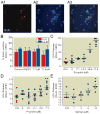
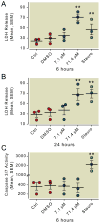


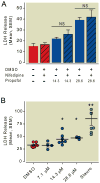
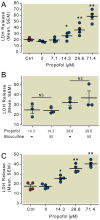
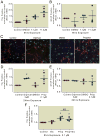
Similar articles
-
Melanocortin-receptor 4 activation modulates proliferation and differentiation of rat postnatal hippocampal neural precursor cells.Neuropharmacology. 2024 Oct 1;257:110058. doi: 10.1016/j.neuropharm.2024.110058. Epub 2024 Jul 1. Neuropharmacology. 2024. PMID: 38960135
-
Isoflurane inhibits growth but does not cause cell death in hippocampal neural precursor cells grown in culture.Anesthesiology. 2009 Apr;110(4):826-33. doi: 10.1097/ALN.0b013e31819b62e2. Anesthesiology. 2009. PMID: 19293697 Free PMC article.
-
Interleukin-1β inhibits the differentiation of hippocampal neural precursor cells into serotonergic neurons.Brain Res. 2013 Jan 15;1490:193-201. doi: 10.1016/j.brainres.2012.10.025. Epub 2012 Oct 22. Brain Res. 2013. PMID: 23085314
-
Effects of isoflurane or propofol on postnatal hippocampal neurogenesis in young and aged rats.Brain Res. 2013 Sep 12;1530:1-12. doi: 10.1016/j.brainres.2013.07.035. Epub 2013 Jul 24. Brain Res. 2013. PMID: 23891717
-
Propofol-induced hippocampal Neurotoxicity: A mitochondrial perspective.Brain Res. 2024 May 15;1831:148841. doi: 10.1016/j.brainres.2024.148841. Epub 2024 Feb 29. Brain Res. 2024. PMID: 38428475 Review.
Cited by
-
Prolonged Treatment with Propofol Transiently Impairs Proliferation but Not Survival of Rat Neural Progenitor Cells In Vitro.PLoS One. 2016 Jul 5;11(7):e0158058. doi: 10.1371/journal.pone.0158058. eCollection 2016. PLoS One. 2016. PMID: 27379684 Free PMC article.
-
Anesthesia and the developing brain: relevance to the pediatric cardiac surgery.Brain Sci. 2014 Apr 16;4(2):295-310. doi: 10.3390/brainsci4020295. Brain Sci. 2014. PMID: 24961762 Free PMC article.
-
Recent Insights Into Molecular Mechanisms of Propofol-Induced Developmental Neurotoxicity: Implications for the Protective Strategies.Anesth Analg. 2016 Nov;123(5):1286-1296. doi: 10.1213/ANE.0000000000001544. Anesth Analg. 2016. PMID: 27551735 Free PMC article. Review.
-
Positron Emission Tomography with [(18)F]FLT Revealed Sevoflurane-Induced Inhibition of Neural Progenitor Cell Expansion in vivo.Front Neurol. 2014 Nov 17;5:234. doi: 10.3389/fneur.2014.00234. eCollection 2014. Front Neurol. 2014. PMID: 25452743 Free PMC article.
-
Effects of Propofol Treatment in Neural Progenitors Derived from Human-Induced Pluripotent Stem Cells.Neural Plast. 2017;2017:9182748. doi: 10.1155/2017/9182748. Epub 2017 Oct 8. Neural Plast. 2017. PMID: 29119024 Free PMC article.
References
-
- Cattano D, Young C, Straiko MM, Olney JW. Subanesthetic doses of propofol induce neuroapoptosis in the infant mouse brain. Anesth Analg. 2008;106:1712–4. - PubMed
-
- Bercker S, Bert B, Bittigau P, Felderhoff-Muser U, Buhrer C, Ikonomidou C, Weise M, Kaisers UX, Kerner T. Neurodegeneration in newborn rats following propofol and sevoflurane anesthesia. Neurotox Res. 2009;16:140–7. - PubMed
-
- Trapani G, Altomare C, Liso G, Sanna E, Biggio G. Propofol in anesthesia. Mechanism of action, structure-activity relationships, and drug delivery. Curr Med Chem. 2000;7:249–71. - PubMed

